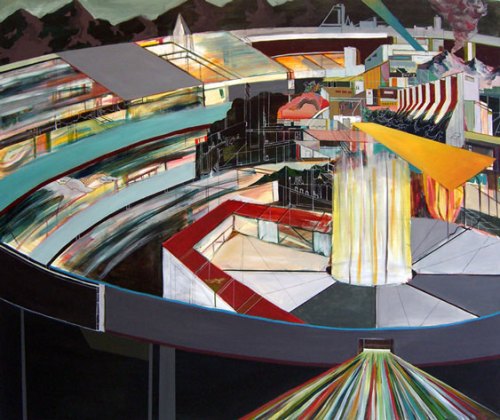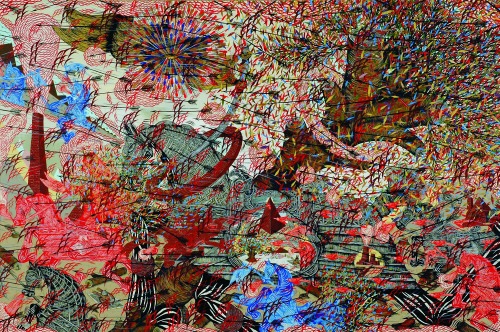by Jason Verhagen

Artist Ricky Allman’s “Apocalyzer,” (2007) an acrylic and ink on canvas, will be featured in the Hyde Park Art Center’s upcoming exhibit, “Signs of the Apocalypse/Rapture.” Image courtesy of Front Forty Press.
Chicago – When scientists and scholars talk about black holes, asteroids and global warming it might be easy to ignore. But when artists depict the apocalypse people could be more likely to see the light. That’s what curators of the “Signs of the Apocalypse/Rapture” exhibit opening at the Hyde Park Art Center July 19 are counting on.
Utah born artist Ricky Allman contributes “Apocalyzer” to the exhibit. He grew up as a Mormon fully believing in and expecting the end of the world to happen any day.
“Many of my works are inspired by religious extremists who are striving and working for the end,” explains Allman. “One group’s utopia is another’s dystopia,” claims Allman, who confesses it is undeniably fascinating to contemplate huge cataclysmic changes altering everything we know.
Photographer and founder Douglas Fogelson of Front Forty Press, the exhibit curators and publishers of the companion book, explains that he and his collaborators spent over two years putting this labor of love together. Fogelson began to notice certain signs of the times and trends in art and music that corresponded with current events including war and climate change.
Fogelson saw that in certain art shows apocalyptic imagery was becoming more prevalent, and at the same time, in the world of music doom-laden bands were making a ripple in the scene.
San Francisco artist Andrew Schoultz is influenced by the effects of globalism and capitalism, and filters themes of man vs. nature in his work that tells stories of everyday life in America. Using graffiti art, underground comics and early 1900s clipart, to name a few forms, Schoultz aims to inform the general public through his murals, illustrations and photographs.

“Running with Chaos, Nature, War & Power,” (2007) an acrylic and collage on wood panel by Andrew Schoultz will also be featured at the “Signs of the Apocalypse/Rapture” exhibit. The show runs from the middle of July through early fall. Image courtesy of Front Forty Press.
In addition to the explanations of scientists and scholars, theologians also offer answers. For years, preachers, apocalyptic thinkers, false prophets and madmen have been predicting the end of the world.
On the spiritual flipside Fogelson explains, “Rapture is often part and parcel of art, but specifically rapturous works are of themselves evoking a certain kind of peak feeling.”
Staying true to their mission statement HPAC features this peculiar exhibit with opposing viewpoints of destruction and ecstasy represented in visual and musical art.
The exhibit will feature works by over 25 artists from all around the globe, and a handful of Chicago artists: Illustrator Mark McGinnis, Cuban born Chicago painter Eduardo de Soignie and Art Institute of Chicago Alum Carrie Schneider, among others.
The exhibit runs from July 19 to Sept. 20. For more information visit the HPAC website.
Copyright 2009









